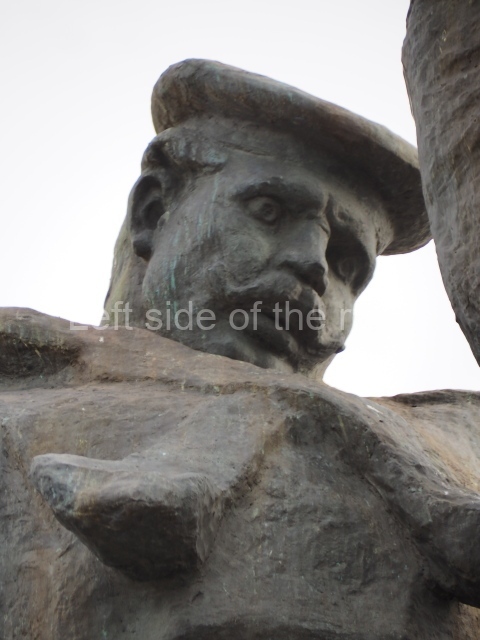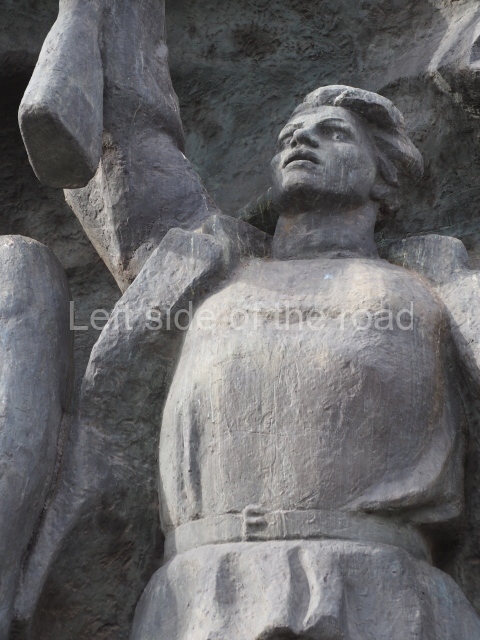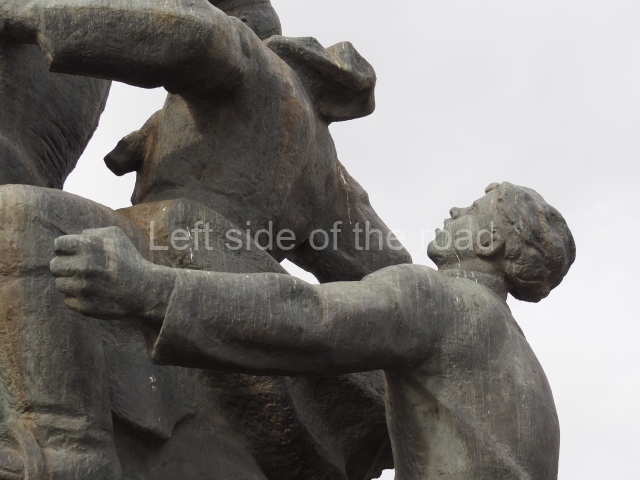
Monument to 1905-1907 Revolution
More on the USSR
Monument to the Heroes of the Revolution of 1905-1907, Moscow
This monument commemorates the first attempt that the Russian workers had in making a revolution in Russia in the 20th century. Although it failed the lessons learnt from that attempt (together with the lessons learnt from the Paris Commune of 1871) meant that the successful Revolution of October (old style) 1917, under the leadership of the Bolsheviks, led by VI Lenin, was possible.
The monument
The story of the monument is basically in three parts.

Monument to 1905-1907 Revolution – 01
On the left there are two figures. A woman is standing and leaning against her legs is a dead or seriously injured male. The woman has both her arms fully extended above her head in the shape of a V (for victory?) and her fists are clenched. Even though the reaction is killing the people she remains defiant and angry, prepared to fight on, even if it means her death. Her face has the look of sadness for the injury/death of her Comrade but also one of determination. The reaction might win now but the future is of the workers.

Monument to 1905-1907 Revolution – 02
On the right there are two workers, a man and a woman, who are taking on one of the Tsarist cavalrymen. They are on the attack even against something as large and powerful as a military horse and its rider. The woman has taken hold of the horses bridle, causing it to rear up on its hind legs. This makes the seating of the soldier unsteady as he falls back and gets lower to the ground. This gives the opportunity for the man to drag the soldier from his saddle and take away his advantage. Once on the ground he will be vulnerable to attack from the rest of the (unseen) crowd. The look of panic on the face of the cavalryman is clear. He is losing this particular battle and it could mean he will also lose his life.

Monument to 1905-1907 Revolution – 02
In the centre is a symbolic grouping of Revolution. Here there are three men, one younger than the other two. The fact that there are three men and no image of a woman is a little bit unusual. I haven’t seen as many Soviet monuments of this sort as I have seen in Albania, but there, in such a circumstance, there is always a female representative to illustrate that this battle for revolution and a change in the life of the working class and peasantry is a fight of both men and women.
Two of the men are standing and one is kneeling. The oldest man in the middle is holding the pole of a huge (red) flag that flutters in the wind behind the group. The red flag is the workers’ flag and as long as that is flying the workers will never be defeated. On his left is a young man, standing with his rifle in his right hand, held high out in front of him – a sign of victory (but here not of 1905-1907 but of the victory to come in 1917). He is in the dress of a Russian peasant at the time – all such monuments stressing the unity of the workers and peasants against Tsarism. The kneeling revolutionary is on the viewers left of the group. He is dressed as an industrial worker and is holding his rifle in his right hand, with its butt resting on the ground. They are all looking ahead, into the future.
The inscription on the podium;
in Russian;
Революции 1905-1907 годов посвящается
in English;
Dedicated to the revolutionary years 1905-1907
Across the road, in Dekabrskaya Park, at the far end, there’s a fine statue of a seated Lenin.
Reading list;
VI Lenin – Pages from his life, Volume 2, the first Russian Revolution 1905-1907
VI Lenin – Lecture on the 1905 Revolution
Date of inauguration;
February 17, 1981, in honour of the 75 anniversary of the Moscow armed uprising in December 1905.
Artists:
OA Ikonnikov and VA Fedorov
Architects;
ME Konstantinov, AM Polovnikov and VM Fursov
Location;
In front of Ulitsa 1905 Goda Metro station, on Line 7, north west of the city centre.
GPS;
55.76362º N
37.56241º E
Related posts;
The bas relief on one of the pylons at the Pantheon of the Working Class Movement in the Fiumei Uti Sirkert, Budapest.
More on the USSR

































